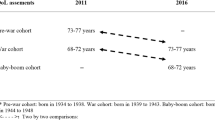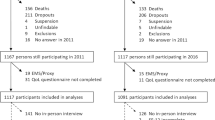Abstract
Purpose
Population aging is a global phenomenon requiring interventions to improve quality of life (QoL), a subjective and dynamic concept. Such interventions should be based on QoL domains considered as important from older people’s viewpoint. It is unclear whether and how much these domains may vary over time as people age. This study aims to assess the importance of QoL domains, their pattern and determinants of change among the non-institutionalized older population over a 5-year period.
Methods
This longitudinal study included community-dwelling older adults (N = 1947, aged 68–77 years at baseline) from the Lausanne cohort 65+. In 2011 and 2016, participants rated the importance of 28 QoL items in seven domains. The difference between scores (0–100) of importance attributed to each QoL domain between two assessments was calculated and used as a dependent variable to assess the associations with covariates in multivariable analysis for each domain.
Results
Importance scores slightly but significantly decreased in five of the seven QoL domains. Despite the majority of participants did not modify their ranking of importance for each QoL domain between the two time points, the proportion of change was still substantial. Bivariate and multivariable analyses showed that education and to a lesser extent age, living arrangement and morbidity, were associated with decrease in the importance of specific QoL domains; characteristics indicating vulnerability (e.g., low education or morbidity) were associated with a decline in the importance.
Conclusion
Although aging individuals modified the importance they give to the seven QoL domains, at population level, changes in opposite directions overall resulted in only small decline; importance seems less stable over time among individuals with vulnerable sociodemographic and health profiles.

Similar content being viewed by others
References
United Nations, Department of Economic and Social Affairs, Population Division. (2015). World population ageing 2015. New York: United Nations, Department of Economic and Social Affairs, Population Division.
Dale, C. E., Bowling, A., Adamson, J., Kuper, H., Amuzu, A., Ebrahim, S., et al. (2013). Predictors of patterns of change in health-related quality of life in older women over 7 years: Evidence from a prospective cohort study. Age and Ageing, 42(3), 312–318. https://doi.org/10.1093/ageing/aft029.
Carr, A. J., Gibson, B., & Robinson, P. G. (2001). Measuring quality of life: Is quality of life determined by expectations or experience? British Medical Journal, 322(7296), 1240–1243.
Kalfoss, M., & Halvorsrud, L. (2009). Important issues to quality of life among norwegian older adults: An exploratory study. Open Nursing Journal, 3, 45–55. https://doi.org/10.2174/1874434600903010045.
Browne, J. P., O’Boyle, C. A., McGee, H. M., Joyce, C. R., McDonald, N. J., O’Malley, K., et al. (1994). Individual quality of life in the healthy elderly. Quality of Life Research, 3(4), 235–244.
Hickey, A. M., Bury, G., O’Boyle, C. A., Bradley, F., O’Kelly, F. D., & Shannon, W. (1996). A new short form individual quality of life measure (SEIQoL-DW): Application in a cohort of individuals with HIV/AIDS. British Medical Journal, 313(7048), 29–33.
Sprangers, M. A., & Schwartz, C. E. (1999). Integrating response shift into health-related quality of life research: A theoretical model. Social Science and Medicine, 48(11), 1507–1515.
Schwartz, C. E., & Sprangers, M. A. (1999). Methodological approaches for assessing response shift in longitudinal health-related quality-of-life research. Social Science and Medicine, 48(11), 1531–1548.
Schwartz, C. E., & Rapkin, B. D. (2004). Reconsidering the psychometrics of quality of life assessment in light of response shift and appraisal. Health and Quality of Life Outcomes, 2, 16. https://doi.org/10.1186/1477-7525-2-16.
Ahmed, S., Mayo, N. E., Wood-Dauphinee, S., Hanley, J. A., & Cohen, S. R. (2004). Response shift influenced estimates of change in health-related quality of life poststroke. Journal of Clinical Epidemiology, 57(6), 561–570. https://doi.org/10.1016/j.jclinepi.2003.11.003.
Razmjou, H., Schwartz, C. E., Yee, A., & Finkelstein, J. A. (2009). Traditional assessment of health outcome following total knee arthroplasty was confounded by response shift phenomenon. Journal of Clinical Epidemiology, 62(1), 91–96. https://doi.org/10.1016/j.jclinepi.2008.08.004.
Ring, L., Hofer, S., Heuston, F., Harris, D., & O’Boyle, C. A. (2005). Response shift masks the treatment impact on patient reported outcomes (PROs): The example of individual quality of life in edentulous patients. Health and Quality of Life Outcomes, 3, 55. https://doi.org/10.1186/1477-7525-3-55.
Barclay-Goddard, R., Epstein, J. D., & Mayo, N. E. (2009). Response shift: A brief overview and proposed research priorities. Quality of Life Research, 18(3), 335–346. https://doi.org/10.1007/s11136-009-9450-x.
Rose, M., Scholler, G., Klapp, B., & Bernheirn, J. (1998). Weighting dimensions in “Generic” QoL Questionnaires by Anamnestic Comparative Self-Assessment: Different weights in different diseases. Quality of Life Research, 655–655.
Netuveli, G., & Blane, D. (2008). Quality of life in older ages. British Medical Bulletin, 85, 113–126. https://doi.org/10.1093/bmb/ldn003.
Chan, S. W., Chiu, H. F., Chien, W. T., Goggins, W., Thompson, D., & Hong, B. (2009). Predictors of change in health-related quality of life among older people with depression: A longitudinal study. International Psychogeriatrics, 21(6), 1171–1179. https://doi.org/10.1017/s1041610209990950.
Santos-Eggimann, B., Karmaniola, A., Seematter-Bagnoud, L., Spagnoli, J., Bula, C., Cornuz, J., et al. (2008). The Lausanne cohort Lc65+: A population-based prospective study of the manifestations, determinants and outcomes of frailty. BioMed Central Geriatrics, 8, 20. https://doi.org/10.1186/1471-2318-8-20.
Henchoz, Y., Meylan, L., Goy, R., Guessous, I., Bula, C., Demont, M., et al. (2015). Domains of importance to the quality of life of older people from two Swiss regions. Age and Ageing, 44(6), 979–985. https://doi.org/10.1093/ageing/afv130.
UNESCO. (2011). Retrieved August 21, 2018, from http://www.uis.unesco.org/Education/Pages/international-standard-classification-of-education.aspx.
Cohen, J. (1988). Statistical power analysis for the behavioral sciences (2nd ed.). Hillsdale: Erlbaum Associates.
Baltes, P. B., & Baltes, M. M. (1990). Psychological perspectives on successful aging: The model of selective optimization with compensation. Successful Aging: Perspectives From the Behavioral Sciences, 1(1), 1–34.
Heckhausen, J., & Schulz, R. (1993). Optimisation by selection and compensation: Balancing primary and secondary control in life span development. International Journal of Behavioral Development, 16(2), 287–303.
Barnett, A. G., van der Pols, J. C., & Dobson, A. J. (2005). Regression to the mean: What it is and how to deal with it. International Journal of Epidemiology, 34(1), 215–220. https://doi.org/10.1093/ije/dyh299.
Molzahn, A. E., Kalfoss, M., Makaroff, S. k., & Skevington, S. M. (2011). Comparing the importance of different aspects of quality of life to older adults across diverse cultures. Age and Ageing, 40(2), 192–199. https://doi.org/10.1093/ageing/afq156.
Molzahn, A., Skevington, S. M., Kalfoss, M., & Makaroff, K. S. (2010). The importance of facets of quality of life to older adults: An international investigation. Quality of Life Research, 19(2), 293–298. https://doi.org/10.1007/s11136-009-9579-7.
Funding
This work was supported by a prize awarded by the Leenaards Foundation. The Lc65+ study has been supported by University of Lausanne Hospital Centre; University of Lausanne Department of Ambulatory Care and Community Medicine; Canton de Vaud Department of Public Health; City of Lausanne; Loterie Romande (research Grant 2006–2008); Lausanne University Faculty of Biology and Medicine (multidisciplinary research Grant 2006); Swiss National Foundation for Scientific Research (Grant 3247B0-120795/1); and Fondation Médecine Sociale et Préventive, Lausanne. The sponsors had no role in the design, execution, analysis and interpretation of data, or writing of the study.
Author information
Authors and Affiliations
Corresponding author
Ethics declarations
Conflict of interest
The authors have no conflict of interest to declare.
Ethical approval
All procedures were in accordance with the 1964 Helsinki declaration and its later amendments or comparable ethical standards. The protocol of the study was approved by the Ethics Committee of the Faculty of Biology and Medicine of the University of Lausanne (Protocol No. 19/04).
Informed consent
Informed consent was obtained from all individual participants in Lc65+.
Confidentiality
The data were collected and coded before being handled for analysis and the investigators were blinded to the identities of the participants.
Electronic supplementary material
Below is the link to the electronic supplementary material.
Rights and permissions
About this article
Cite this article
Abolhassani, N., Santos-Eggimann, B., Bula, C. et al. Temporal changes in importance of quality of life domains: a longitudinal study in community-dwelling Swiss older people. Qual Life Res 28, 421–428 (2019). https://doi.org/10.1007/s11136-018-1983-4
Accepted:
Published:
Issue Date:
DOI: https://doi.org/10.1007/s11136-018-1983-4




